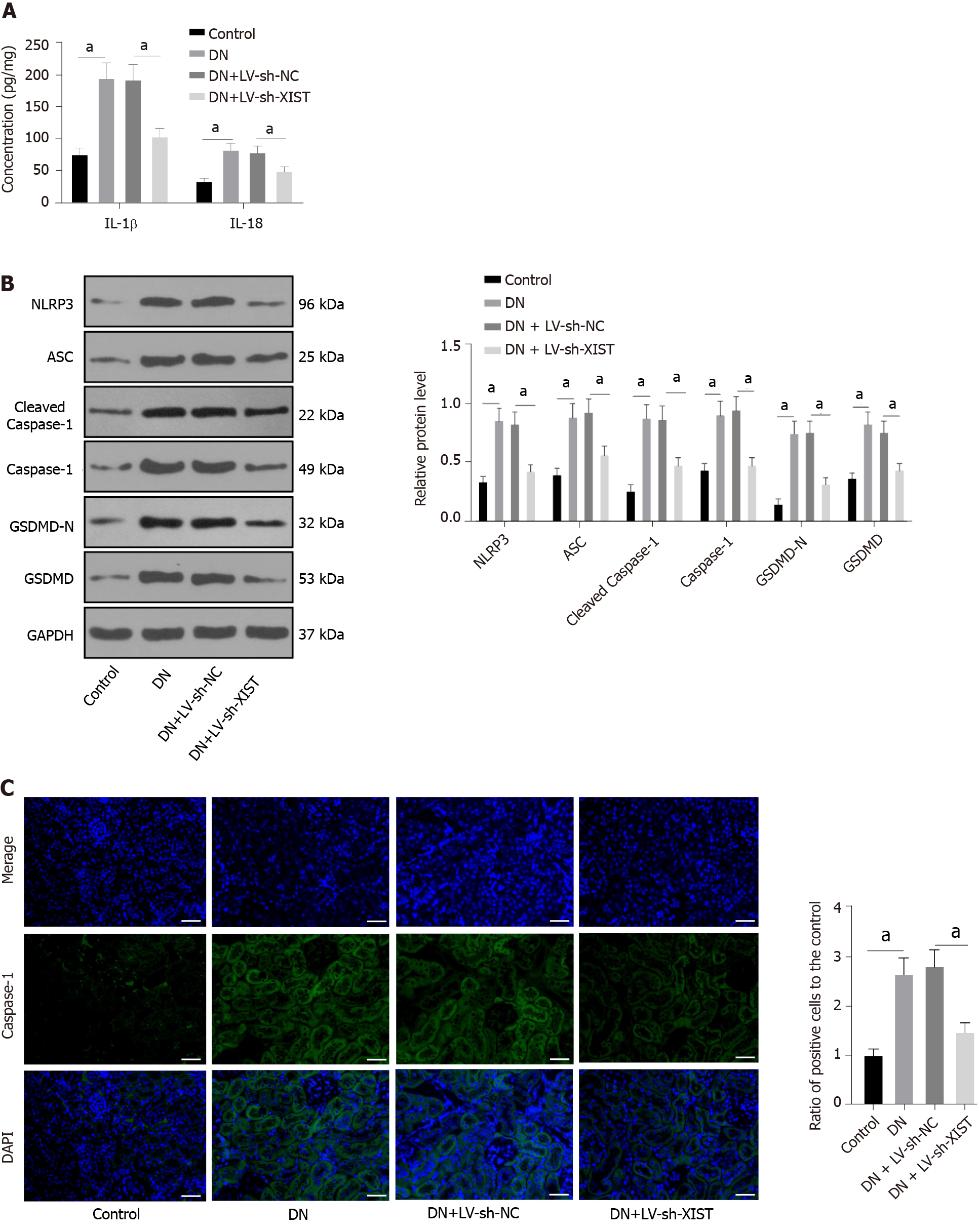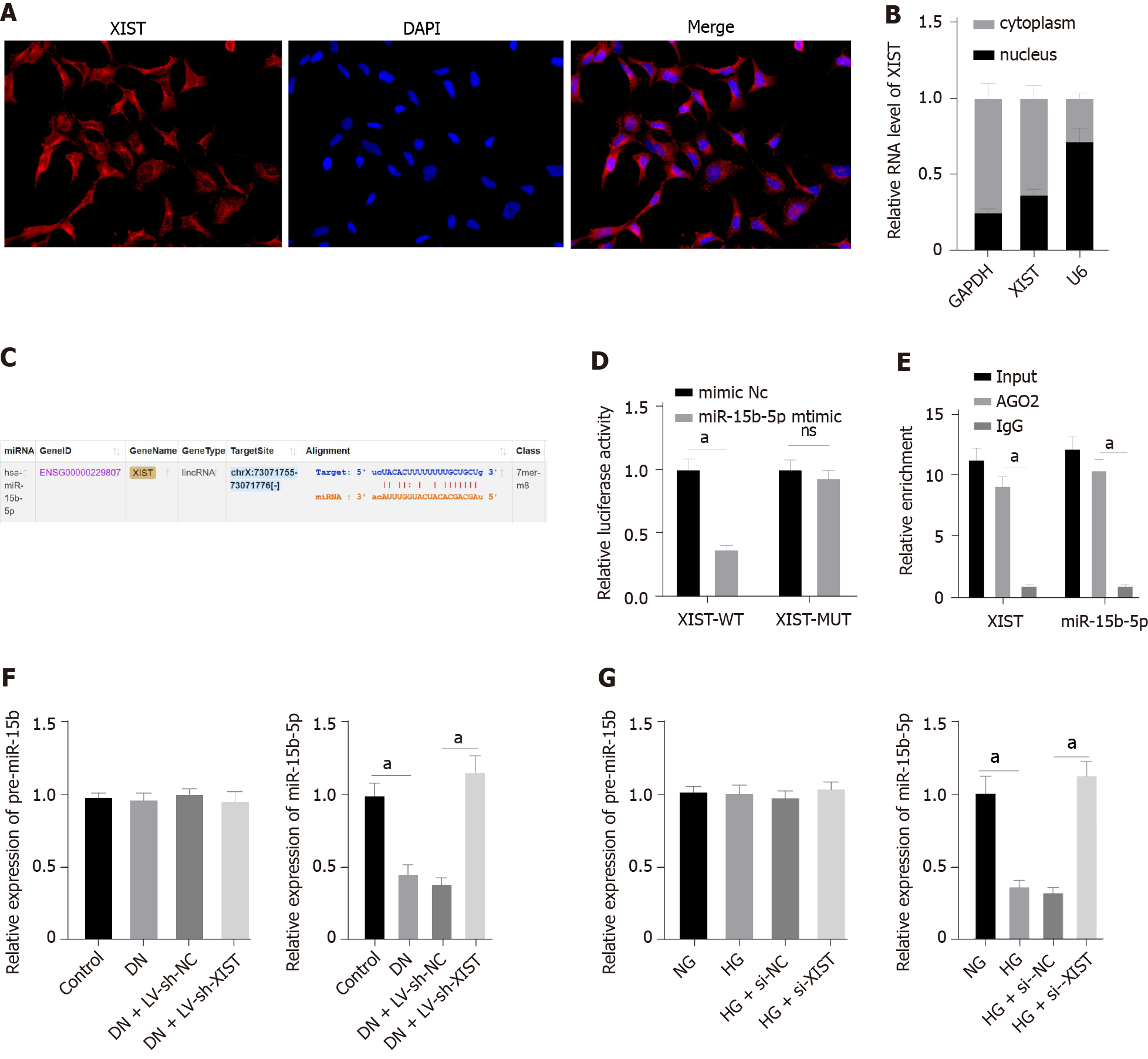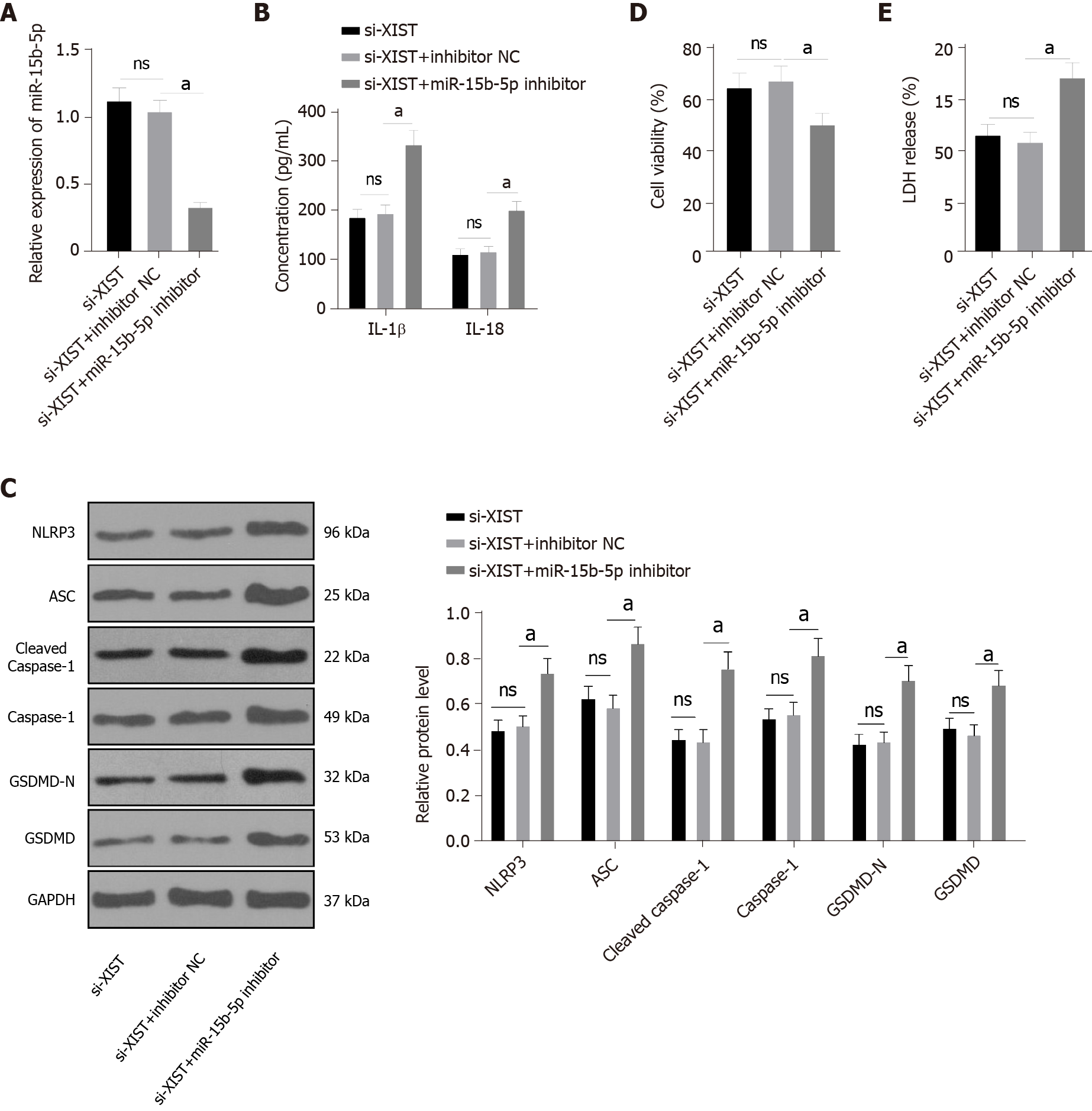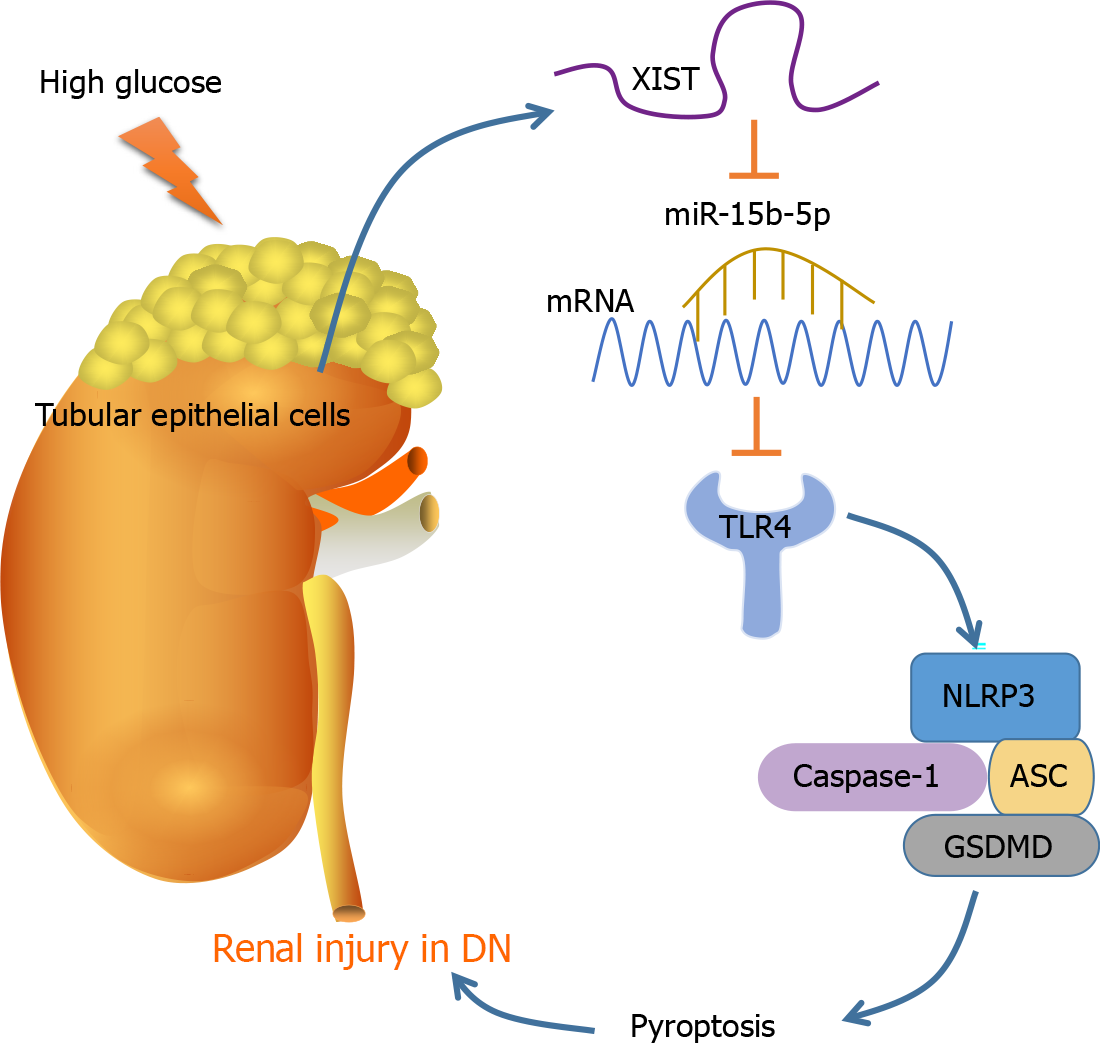Copyright
©The Author(s) 2022.
World J Diabetes. Apr 15, 2022; 13(4): 358-375
Published online Apr 15, 2022. doi: 10.4239/wjd.v13.i4.358
Published online Apr 15, 2022. doi: 10.4239/wjd.v13.i4.358
Figure 1 Silencing lncRNA X inactive specific transcript can inhibit renal injury in DN rats.
After establishing DN model rats, lentivirus-LV sh- X inactive specific transcript (XIST) was injected into the tail vein to knock down XIST expression in vivo. A: XIST expression detected by qRT-PCR; B: Kidney weight/body weight (KW/BW); C: Fasting blood glucose (FBG); D: Blood urea nitrogen (BUN); E: Serum creatinine (Cr); F: Urine protein for 24 h (UP 24 h); G: Histological changes of renal tissue estimated by HE staining, PAS staining and Masson staining; scale bar: 25 μm; arrows indicate inflammatory cell infiltration (black arrows) and fibrosis (white arrows). (g) glomerulus, (t) tubules; n = 8/group. The data were described as mean ± SD and analyzed by one-way ANOVA and Tukey's multiple comparisons test; aP < 0.05. DN: Diabetic nephropathy; LV: Lentivirus; XIST: X inactive specific transcript; sh: Short hairpin RNA; HE: Hematoxylin-eosin staining; PAS: Periodic Acid-Schiff stain.
Figure 2 Silencing lncRNA X inactive specific transcript can inhibit renal tubular epithelial cell pyroptosis in diabetic nephropathy rats.
After establishing diabetic nephropathy model rats, lentivirus-LV sh- X inactive specific transcript was injected into the tail vein. A: Enzyme-linked immunosorbent assay detected IL-1β and IL-18 expressions; B: Western blot tested the levels of NLR family pyrin domain containing 3, ASC, Cleaved Caspase-1, Caspase-1, GSDMD, and GSDMD-N; C: Immunofluorescence tested the expression of Caspase-1; scale bar: 25 μm; N = 8/group. The data were described as mean ± SD and analyzed by one-way ANOVA and Tukey's multiple comparisons test; aP < 0.05. DN: Diabetic nephropathy; LV: Lentivirus; XIST: X inactive specific transcript; sh: Short hairpin RNA; NLRP3: NLR family pyrin domain containing 3; ASC: Apoptosis speck-like protein; GSDMD: Gasdermin D; DAPI: 4',6-diamidino-2-phenylindole.
Figure 3 Silencing X inactive specific transcript in diabetic nephropathy can inhibit renal tubular epithelial cell pyroptosis in high glucose-induced HK2 cells.
si-NC or si- X inactive specific transcript (XIST) was delivered into HK2 cells treated with high glucose. A: The XIST expression detected by qRT-PCR; B: Enzyme-linked immunosorbent assay detected the expression of IL-1β and IL-18; C: Western blot tested the levels of NLR family pyrin domain containing 3, ASC, Cleaved Caspase-1, Caspase-1, GSDMD, and GSDMD-N; D: Cell viability; E: Lactate dehydrogenase activity. The cell experiment was performed in triplicate. The data were described as mean ± SD and analyzed by one-way ANOVA (A/D-E) or two-way ANOVA (B/C) and Tukey's multiple comparisons test; aP < 0.05. NG: Normal glucose; HG: High glucose; si: Small interfering RNA; XIST: X inactive specific transcript; LDH: Lactate dehydrogenase; NLRP3: NLR family pyrin domain containing 3; SC: Apoptosis speck-like protein; GSDMD: Gasdermin D.
Figure 4 X inactive specific transcript can adsorb and bind to miR-15b-5p to reduce miR-15b-5p expression in diabetic nephropathy.
A: Fluorescence in situ hybridization assay (scale bar: 25 μm); B: Nuclear/cytosol fractionation assay verified the subcellular localization of X inactive specific transcript (XIST) in HK2 cells; C: Starbase website (starbase.sysu.edu.cn/index.php) predicted the binding sites of XIST and miR-15b-5p; D: Dual-luciferase experiment and E: RNA immunoprecipitation experiment verified the binding relation of XIST and miR-15b-5p; F: qRT-PCR detected miR-15b-5p and pre-miR-15b expression in renal tissue; G: qRT-PCR detected miR-15b-5p and pre-miR-15b expression in HK2 cells. The cell experiment was performed in triplicate. The data were described as mean ± SD and analyzed by one-way ANOVA (F/G) or two-way ANOVA (D/E) and Tukey's multiple comparisons test; aP < 0.05. XIST: X inactive specific transcript; DN: Diabetic nephropathy; DAPI: 4',6-diamidino-2-phenylindole; GAPDH: Glyceraldehyde-3-phosphate dehydrogenase; U6: U6 small nuclear RNA; WT: Wild type; MUT: Mutant.
Figure 5 Inhibition of miR-15b-5p in X inactive specific transcript -silenced HK2 cells activates renal tubular epithelial cell pyroptosis.
In HG-treated HK2 cells, both X inactive specific transcript (XIST) and miR-15b-5p were silenced. A: qRT-PCR verified the transfection efficiency of miR-15b-5p inhibitor; B: Enzyme-linked immunosorbent assay detected the expression of IL-1β and IL-18; C: Western blot tested the levels of NLR family pyrin domain containing 3, ASC, Cleaved Caspase-1, Caspase-1, GSDMD, and GSDMD-N; D: Cell viability; E: Lactate dehydrogenase activity. The cell experiment was performed in triplicate. The data were described as mean ± SD and analyzed by one-way ANOVA (A/D-E) or two-way ANOVA (B/C) and Tukey's multiple comparisons test; aP < 0.05. LDH: Lactate dehydrogenase; XIST: X inactive specific transcript; si: Small interfering RNA; NLRP3: NLR family pyrin domain containing 3; ASC: Apoptosis speck-like protein; GSDMD: Gasdermin D.
Figure 6 Toll like receptor 4 expression is recovered by using miR-15b-5p inhibitor.
A: Starbase website (starbase.sysu.edu.cn/index.php) predicted the binding sites of miR-15b-5p and toll like receptor 4 (TLR4); B: Dual-luciferase experiment and C: RNA immunoprecipitation experiment verified the binding relation of miR-15b-5p and TLR4; D: qRT-PCR detected TLR4 expression in renal tissues; E: Western blot detected TLR4 level in renal tissues; F: qRT-PCR detected TLR4 expression in HK2 cells; G: Western blot detected TLR4 level in HK2 cells. The cell experiment was performed in triplicate. The data were described as mean ± SD and analyzed by one-way ANOVA (D-G) or two-way ANOVA (B/C) and Tukey's multiple comparisons test; aP < 0.05. WT: Wild type; MUT: Mutant; TLR4: Toll like receptor 4; DN: Diabetic nephropathy; LV: Lentivirus; XIST: X inactive specific transcript; NG: Normal glucose; HG: High glucose; GAPDH: Glyceraldehyde-3-phosphate dehydrogenase.
Figure 7 Toll like receptor 4 overexpression in X inactive specific transcript-silenced cells causes increased pyroptosis.
In HG-treated HK2 cells, X inactive specific transcript (XIST) was silenced and toll like receptor 4 (TLR4) was overexpressed. A and B: The expression of TLR4 levels detected by qRT-PCR and Western blot; C: Enzyme-linked immunosorbent assay detected the expression of IL-1β and IL-18; D: Western blot tested the levels of NLR family pyrin domain containing 3, ASC, Cleaved Caspase-1, Caspase-1, GSDMD, and GSDMD-N; E: Cell viability; F: LDH activity. The cell experiment was performed in triplicate. The data were described as mean ± SD and analyzed by one-way ANOVA (A/B/E/F) or two-way ANOVA (C/D) and Tukey's multiple comparisons test; aP < 0.05. XIST: X inactive specific transcript; GAPDH: Glyceraldehyde-3-phosphate dehydrogenase; LDH: Lactate dehydrogenase; NLRP3: NLR family pyrin domain containing 3; ASC: Apoptosis speck-like protein; GSDMD: Gasdermin D.
Figure 8 Mechanism diagram.
STZ and HG treatment induced high expression of X inactive specific transcript (XIST); silencing XIST promoted the targeted inhibition of miR-15b-5p on toll like receptor 4 (TLR4) by upregulating miR-15b-5p, thereby inhibiting TLR4, and ultimately alleviating the renal injury of diabetic nephropathy by inhibiting NLRP3/Caspase-1-mediated RTEC pyroptosis. mRNA: messenger RNA; DN: Diabetic nephropathy; NLRP3: NLR family pyrin domain containing 3; ASC: Apoptosis speck-like protein; GSDMD: Gasdermin D.
- Citation: Xu J, Wang Q, Song YF, Xu XH, Zhu H, Chen PD, Ren YP. Long noncoding RNA X-inactive specific transcript regulates NLR family pyrin domain containing 3/caspase-1-mediated pyroptosis in diabetic nephropathy. World J Diabetes 2022; 13(4): 358-375
- URL: https://www.wjgnet.com/1948-9358/full/v13/i4/358.htm
- DOI: https://dx.doi.org/10.4239/wjd.v13.i4.358
















